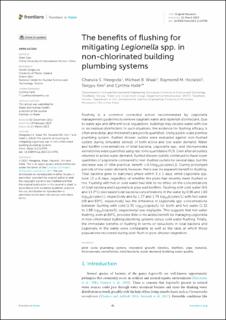| dc.description.abstract | Flushing is a common corrective action recommended by Legionella management guidelines to remove stagnant water and replenish disinfectant. Due to water age and different local regulations, buildings may receive water with low or no residual disinfectant. In such situations, the evidence for flushing efficacy is often anecdotal, and the benefits are poorly quantified. Using a pilot-scale premise plumbing system, flushed shower outlets were evaluated against non-flushed outlets during simulated periods of both active and low water demand. Water and biofilm concentrations of total bacteria, Legionella spp., and Vermamoeba vermiformis were quantified using real-time quantitative PCR. Even after all outlets returned to active water demand, flushed shower outlets continued to have lower quantities of Legionella compared to non-flushed outlets for several days, but the decrease was of little practical benefit (<0.5 log10[copies/L]). During prolonged periods of low water demand, however, there was no apparent benefit to flushing. Total bacteria grew to stationary phase within 3 ± 1 days, while Legionella spp. took 12 ± 6 days, regardless of whether the pipes had recently been flushed or not. Flushing with hot or cold water had little to no effect on the concentrations of total bacteria and Legionella in pipe wall biofilms. Flushing with cold water (9.6 and 13.2°C) decreased total bacteria concentrations in the water by 0.96 and 1.00 log10[copies/L], respectively and by 1.27 and 1.74 log10[copies/L] with hot water (49 and 60°C, respectively) but the difference in Legionella spp. concentrations between flushing with cold (1.55 log10[copies/L] for both) and hot water (1.32 to 1.88 log10[copies/L], respectively) was negligible. This suggests that hot water flushing, even at 60°C, provides little or no added benefit for managing Legionella in non-chlorinated building plumbing systems versus cold water flushing. Finally, the immediate benefits of flushing in terms of reductions in total bacteria and Legionella in the water were comparable as well as the rates at which those populations recovered during post-flush or post-shower stagnation. | en_US |

